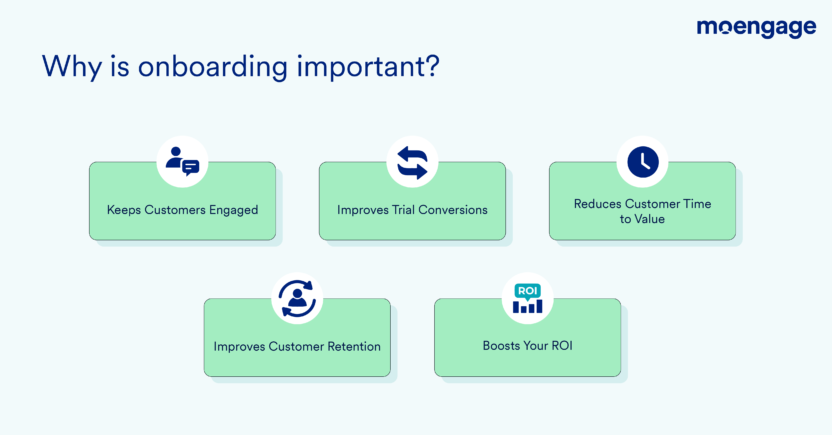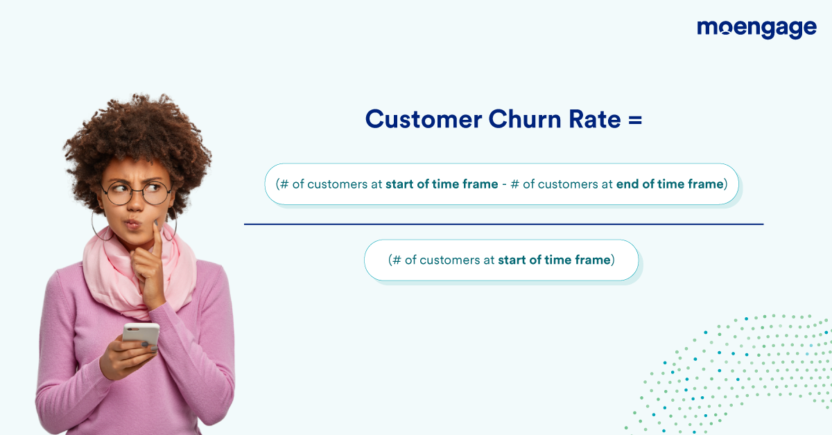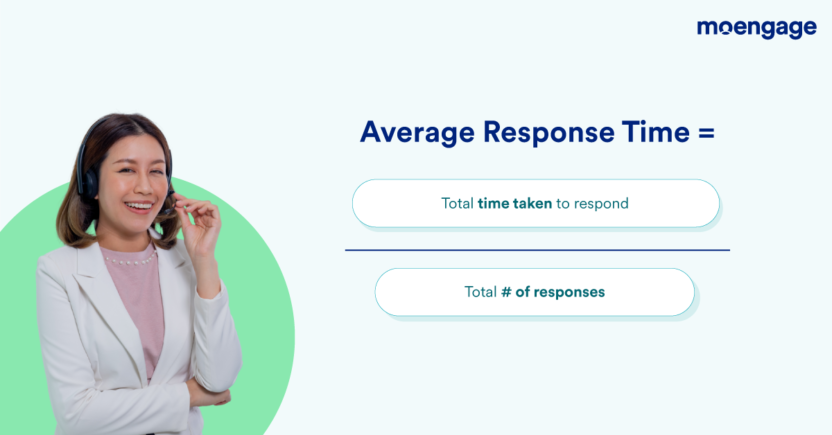The Top 10 Customer Onboarding Metrics to Prioritize in 2023

Reading Time: 7 minutes
Are you looking for customer onboarding metrics to assess the effectiveness of your onboarding strategy?
Onboarding is arguably the most crucial period of your sales process.
While it comes after the customer has made a purchase, the make-or-break period sets the tone for their relationship with your business.
Customer onboarding is a complex process as it is difficult to understand what’s working, what’s not, and how to plug gaps effectively.
So, how do you generate an onboarding process that delivers your promises related to your ROI?
In this post, I’ll take a closer look at the top ten onboarding metrics and tips to analyze them to help you optimize your onboarding. Let’s get started.
What is Customer Onboarding?
Customer onboarding refers to introducing new customers to your product or service. It teaches new customers how to get the most out of your product or service. Customers onboarding covers the journey from the initial sign-up to product/service activation to the first use of your product/service.
If done well, it demonstrates your brand’s value and sets it up for success. You can even predict the probability of retaining or not retaining specific customers and customize your tactics accordingly.
However, if done poorly, it leaves your new customers disappointed and questioning why they signed up for your business.
Why is Customer Onboarding Important?

Customer onboarding influences how customers use your products/services long-term or churn after a few months. The importance of customer onboarding cannot be over-emphasized. This is because it sets the tone for the continued relationship between your customers and your brand.
A well-structured and executed customer onboarding process has the following benefits:
- It keeps your customers engaged. Customer onboarding keeps your customers happy and probably returning for more services/products. If your customers understand the value of your services/products, they’ll start using them successfully, giving them a reason to return for more.
- It improves trial conversions. Offering discounted or free product trials enables your customers to experience the value of your brand. If they understand the value of your brand, they’ll likely convert to paying customers, ultimately improving your sales.
- It reduces customer time to value. Customer onboarding helps you save time as customers purchase your product only when they realize its value.
- It enhances customer retention. Loyal and repeat customers are what generate revenue for the business. The more valuable customers find your brand, the less likelihood of churning.
- It saves your business money. Customer onboarding helps you eliminate the need for extensive and costly customer service teams.
Top 10 Customer Onboarding Metrics to Prioritize in 2023
Measuring the efficiency and effectiveness of your customers’ onboarding process can be challenging and requires analyzing the right customer onboarding metrics within a customer success platform.
Each customer touch point provides a deep understanding of the customer journey and current status. Keeping track of the critical metrics helps you tweak your onboarding strategy and fast-tracks you to success.
Now, let’s talk about onboarding metrics.
1. Time to Value(TTV)
Time to value refers to the total time it takes for a customer to realize and experience the value they expected from your service/ product.
You can use various tactics to convince customers that your products are superior to your competitors. However, they need to start ‘feeling’ and realizing the product’s value as soon as they sign up.
When will your customers find the value of your brand? Customers expect to see the value of a product as soon as possible.
The shorter the time to value is, the better the customer’s first impression and experience.
By contrast, a high time to value points is a frustrating customer experience. The fix? Create a customer success plan that informs customers and showcases the value of your brand from the beginning of your first customer interaction.
2. Time to Complete Onboarding
The customer onboarding process should be focused on demonstrating how fast your brand will benefit the customers.
Customers remain in the onboarding phase until they can integrate your product into their workflow independently. And, the shorter their time to become independent, the faster they realize the value.
Therefore, the time your customers take for onboarding is essential to analyze.
To measure this metric, find the number of days customers can use your products independently.
It starts with the customer’s first experience with your product until they begin using it independently.
Knowing the number of days it takes to onboard a customer gives you an overview of your performance.
Moreover, you can use this number as a benchmark for the future if you want a quick onboarding process.
3. Customer Response Rate
One of the most common questions I get from businesses is: What type of customer response rate can I expect?
The average survey response rate is approximately 33%, though you should aim for a higher response rate.
Customers face obstacles and challenges during the onboarding process and have many questions.
You can conduct regular surveys and direct questionnaires, gather feedback and log the most common pain points and queries into your customer success platform for analyzing.
A low response rate indicates that your customers may be interested in something other than your products/services.
In this case, find methods to engage customers and offer personalized experiences.
4. Escalation Response Time
Mistakes are bound to happen, no matter the effectiveness of your customer support team or how impressive your product is. How you handle customer complaints substantially impacts customer loyalty and growth. Customers want immediate solutions to their issues.
In a nutshell, escalation response time is the time taken to resolve a customer complaint from when they were logged in.
Your customer success platform should analyze such responses to help identify escalation trends and patterns and alert you on systemic issues.
When you quickly resolve customer complaints, you build trust and loyalty.
5. Customer Churn Rate

Also known as attrition rate, customer churn rate is the number of customers that cease using your product/service by canceling their subscriptions.
No business wants to lose customers. Customers churn when they need to learn how to make the best use of your product or when they need to realize their value and full potential.
The better the customer onboarding process is, the lower the churn rate.
To determine your customer churn rate, divide the number of customers that drop your product over a given time by the total number of customers at the start of that period, then multiply by 100.
This number helps you know how many customers dropped your products and when they left the sales funnel.
6. Trial to Paid Conversion Rate
This is one of the most crucial SAAS customer onboarding metrics that every company must analyze. It refers to the number of consumers that sign up as paying customers after the free trial period.
Offering free product trials is a powerful marketing strategy. It allows customers to glimpse what they’ll get if they sign up. If they’re satisfied, they’ll most likely make a purchase.
Have you ever thought that the consumers using your free trials will already be familiar with your product and, therefore, will take less time to realize your product’s value once they sign up?
7. Product Adoption Rates
Product adoption rate refers to how effectively and often customers use your products. Most companies define product adoption in several ways, which reflect the following product onboarding metrics:
- Customers that explored or encountered your product but didn’t use it.
- Customers that interacted with your product by testing, activating, or using it at least once.
- Customers that used the product at least two times.
The general idea is that customers found your product, used it, and if they use it regularly, they’ve adopted it.
To determine this metric, divide the number of new active users by the total number of sign-ups, then multiply by 100.
High product adoption rates increase the chance of customers sticking to your brand and reduce churn rates.
8. Customer Lifetime Value(LTV)
This refers to the projected revenue from paying customers for the time they interact with your brand. It’s a critical indicator for evaluating the success of your onboarding actions.
To determine your customer lifetime value, divide the average revenue per account by the customer churn rate.
9. Total Contract Value
The total contract value measures how much your customer contract is worth after execution. It accounts for recurring revenue and any onboarding fees. Unlike customer lifetime value, it takes a more solid and backed-up data approach to predict growth and revenue.
It’s a SAAS customer onboarding metric based on existing contract commitments and gives a clear idea of customers that generate the most or most negligible revenue.
If your onboarding strategy is powerful, you can achieve a high total contract value for each customer segment.
10. Average Response Time
This refers to the time it takes to respond to customer inquiries. It helps you understand customer experience and gives insight into the efficiency of your customer service.
Businesses have recently embraced chats, email autoresponders, and chatbots to respond immediately to customer inquiries.

Wrapping It Up
Customer onboarding metrics help you achieve an effective onboarding process and set your customers up for success.
Measuring the wrong metrics wastes your time, resources, and effort. Therefore, it’s essential you know and optimizes the right metrics that directly reflect customer experience. Moreover, using ultra-modern marketing tools makes your onboarding easier.
At no point in the sales funnel should your customers feel frustrated. It’s in the business’s best interest to ensure your customers realize the value of your products. And having customer onboarding metrics is a great way to get you started.
Once you understand the right customer onboarding metrics, ensure you regularly analyze them and use the generated insights to boost your onboarding strategies.
Explain your product’s value on each customer journey phase, and adopt the best onboarding practices to get the positive results you’ve been hoping to achieve.







